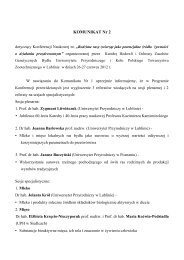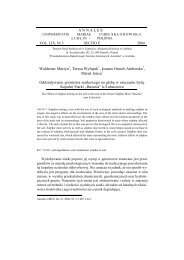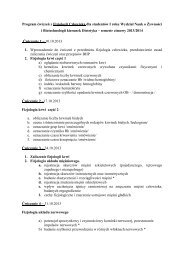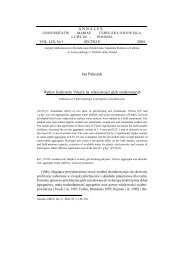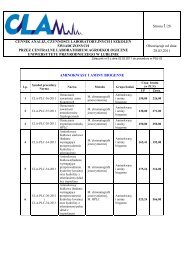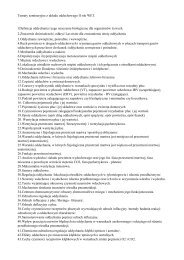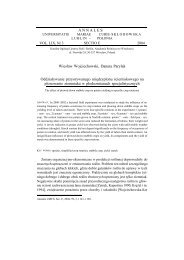Canine calcinosis circumscripta â retrospective studies
Canine calcinosis circumscripta â retrospective studies
Canine calcinosis circumscripta â retrospective studies
You also want an ePaper? Increase the reach of your titles
YUMPU automatically turns print PDFs into web optimized ePapers that Google loves.
Medycyna Wet. 2008, 64 (12) 1399Fig. 3. Macroscopic view of <strong>calcinosis</strong> <strong>circumscripta</strong>Fig. 4. Microscopic view of <strong>calcinosis</strong> <strong>circumscripta</strong>. Note thevisible proliferating granulomatous inflammation in the surroundingsof the calcium masses. Stain HE, magnification 100 ×moderate pressure. The calcified masses were usually foundto be hypovascularized, occasionally supplied with small--sized blood vessels or more frequently, the absence of bloodvessels within their area was noted. The size of lesions excisedin the early stage of treatment averaged from 0.5 to 1.5 cm.The other pathological changes were variably sized even upto 3-5 cm in diameter. The consistency of resected formationsvaried from semi-liquid to solid, brittle mass of oval shapes.The cut section of the aggregates had chalky calcified foci(fig. 3). During the follow-up period the patients were providedwith an antibiotic cover.The surgically removed mineralized cutaneous masses weresubmitted to histopathologic evaluation. The collected segmentswere fixed in buffered formalin, embedded in paraffin,processed to sections and stained with hematoxylin and eosin.The microscopic picture of studied lesions revealed basophiliccalcified mass stained violet under hematoxylin and eosin.Quite frequently, the aggregates of calcification were surroundedby a visible inflammatory-granulomatous reactionoccurring as a proliferating fibroconnective tissue (fig. 4).Disease recurrence was reported in three cases, a short timeafter surgical treatment, i.e. 2 months post operation, in twodogs and a year after in one dog. The recurrent lesions weresmall-sized and painless. Only one animal had another surgeryperformed after two years.Results and discussionCalcinosis <strong>circumscripta</strong> (CC) is presented in literatureas a disorder affecting both humans and variousspecies of animals. In medicine CC defines smallmineralized foci formed within the subcutaneous tissue.Bigger lesions located in the connective tissue arecalled tumoral <strong>calcinosis</strong>, but both terms are equallyapplicable in veterinary medicine (1, 11, 14). However,in the literature this disorder has been identifiedby many names, such as cutaneous <strong>calcinosis</strong>, calciumgout, lipo<strong>calcinosis</strong>, apocrine cystic <strong>calcinosis</strong>, hipstone, Kalkgicht, which follows from the fact that thepathogenesis of this disease is not established (6, 14,15). Therefore, considering the potential etiology ofCC, different factors are taken into account, whichmakes it possible to classify the disorder into a fewcategories.Pathological processes that damage cutaneous tissues,impair proper blood supply and nutrient flow arelikely to induce calcium deposition. These processesinclude, among others, connective tissue diseases, trauma,neoplasms, degeneration as well as formation ofabscesses, hematomas and granulomas. This type of<strong>calcinosis</strong> is termed dystrophic and is not associatedwith calcium and phosphorus concentration in bloodserum (6, 14, 15). The same group may include iatrogenic<strong>calcinosis</strong> mentioned while discussing the surgicalprocedures performed earlier as well as combinedtreatment with medroxy-progesterone and proligestoneinjections (4, 5, 9, 12, 14-16). Calcinosis incidencehas been reported as a result of long-standinginflammations caused by a foreign body, among others,polydioxanone suture material, otitis externa, interdigitalspace inflammation, demodicosis, neoplasticand degenerative changes detected within apocrineglands as well as urate gout (6, 7, 11-16). Most <strong>calcinosis</strong><strong>circumscripta</strong> lesions described were formed incutaneous tissues close to the joints and over bony prominences,where tissue is especially susceptible to injury.That may support the theory of trauma being themechanism responsible for CC lesion development.In three cases reported (17%) calcification occurreddue to an apparent damage to tissues, whereas in theother reports no single cause was established. However,mechanical trauma can not be ruled out asa mechanism promoting or contributing to the formationof these pathological changes. None of the dogshad similar symptoms in the case history and noneof them had surgical procedures performed in theaffected region earlier. Only in one patient <strong>calcinosis</strong>circumcripta was not the only disease that occurred.A six-month-old West Highland White Terrier waspresented initially to the Clinic and Department ofAnimal Surgery for severe deformations of the mandibleregion that persisted for over 2 weeks. TheX-ray evaluation of the puppy’s head revealed thepresence of cranial mandibular osteopathy. A sub-
1400humeral lesion which was diagnosed as <strong>calcinosis</strong>circumripta occurred twelve days later.The present <strong>studies</strong> also suggest considering thegenetic component of the animal owing to the fact thatall the dogs with lesions recognized belonged to thegroup of animals susceptible to <strong>calcinosis</strong> <strong>circumscripta</strong>.The only exception was a 3-year-old French Bulldog,whose pathological change was located in the calcaneantuber region. So far this breed has not been mentionedas predisposed for <strong>calcinosis</strong> and this is the firstreport of this disease in the French Bulldog breed. 90%of this group was made up of large breed dogs, out ofwhich 60% were German Shepherd Dogs that are affectedby this disease most frequently. Unfortunately,no information regarding such pathological changesoccurring in the affected puppies, their siblings andparents (familial incidence) was available. Still, a pointmutation in the type II protocollagen gene is believedto play a role in etiology of this human and animaldisease and a hereditary form of the disorder is suggestedto be linked to the autosomal recessive gene(12, 15). Great Dane Dogs and Pointers are most likelyto develop lesions that occur in a generalized form,<strong>calcinosis</strong> universalis (7, 12). In Boxers and BostonTerriers the pathological changes involve ear pinnaeand cheeks, whereas in Poodles and their crossbreeds,the focal calcifications were formed as a response tomedroxy-progesterone acetate administration (3, 12,15).Metastatic calcification is reported in both humansand animals with mineralized foci occurring secondarilyto derangements in blood serum calcium andphosphorus (9). Other potential disorders with whichmetastatic calcification is associated include hyperparathyroidism,milk-akali syndrome, some diseasesand neoplasms causing bone destruction and hypervitaminosisD (4-6, 10, 11, 15). In dogs it is recognizedas secondary to chronic renal failure, and the animalshad characteristic symmetrical mineralized foci of thedigital footpad area. Symmetrically developed calcificationwas also found in hypertrophic osteodystrophyand idiopathic polyarthritis (2). However, in only fewcases the involvement of visceral organs (stomachmucus, renal tubules, pulmonary alveolus wall) andblood vessel walls was reported (8, 11, 14).Calcification in association with renal failure mayproduce the systemic symptoms typical of the primarydisease, i.e. body weight loss, apathy, polyuria, polydipsia,urinary incontinence.The laboratory examinations performed revealedincreased blood urea nitrogen (BUN) and creatinineconcentrations as well as a marked rise in the serumcalcium/phosphorus product, elevated blood serumsodium level and metabolic acidosis development. Theultrasonographic evaluation exhibited kidneys withthin cortices. A cure of the underlying disorder mayinduce the complete remission of the lesions in thefootpad pulp (9). Only one case of a dog, an 11-month-Medycyna Wet. 2008, 64 (12)-old German Shepherd, reported in the paper had proliferativeand painful lesions in the metacarpal digitalpawpad region. Additionally, substantial enamel defectsin all the teeth were established. The patient hadno clinical signs associated with renal failure. In thiscase laboratory examinations, including blood calciumand phosphorus level, were performed. They did notreveal any departures from normal. Ultrasonographicexamination was not carried out in this case.General clinical signs such as elevated body temperatureand apathy were presented in one animal. Thedog developed a marked edema of the extremity distalto the lesion (medial aspect of tarsal joint), which mayarise from pressure on the blood vessels running by. Infive cases (28%) additional inflammation was producedand these animals showed pain and anxiety atclinical examination.In the group of thirteen dogs (72%) palpable lesionsproved to be painless, strongly connected with the tissueand hardly movable. The overlying skin remainedunchanged and movable. In three cases (17%) onlywhere tissue damage appeared in the affected region,there occurred slight bleeding or exudates.The diagnosis of <strong>calcinosis</strong> <strong>circumscripta</strong> relies onclinical signs, radiographic findings and histologicexamination. A surgical resection of the lesions islikely to produce a cure. The recurrence of the pathologicalprocess is reported only occasionally. As thespecific cause for CC development is still unknown,upon the occurrence of generalized mineralized depositionsan animal should be examined for the presenceof an underlying disease process.References1.Barr F. J., Kirberger R. M.: BSAVA Manual of <strong>Canine</strong> and Feline MusculoskeletalImaging. BSAVA, Gloucester 2006, 5.2.Bettini G., Morini M., Campagna F., Preziosi R.: True git: the tale of a subcutaneousmass in a dog. Vet. Clin. Path. 2005, 34, 73-75.3.Ginel P. I., Lopez R., Rivas R., Perez J., Mozos E.: A futher case of medroxyprogesteroneacetate associated with <strong>calcinosis</strong> circumcripta in the dog. Vet.Sci. 1994, 57, 44-45.4.Houszka M., Ratajczak K., Salem H.: Calcinosis tumoralis i <strong>calcinosis</strong> circumcriptau psów. Medycyna Wet. 1978, 3, 146-149.5.Jeong W., Noh D., Kwon O., Williams B., Park S., Lee M., Do S., Chung J.,Lee G., You H., Jeong K.: Calcinosis circumcripta on lingual muscles anddermis in a dog. J. Vet. Med. Sci. 2004, 66, 433-435.6.Joffe D. J.: Calcinosis circumcripta in the footpad of a dog. Can. Vet. J. 1996,37, 161-162.7.Jubb K. V. F., Kennedy P. C., Palmer N.: Pathology of Domestic Animals.Academic Press, San Diego 1993, 14-15.8.Kaealy J. K., McAllister H.: Diagnostic Radiology and Ultrasonography of theDog and Cat. Elsevier Inc., St. Louis 2005, 477-480.9.Komori S., Washizu M.: Metastatic <strong>calcinosis</strong> circumcripta treated with an oralcharcoal absorbent in a dog. J. Vet. Med. Sci. 2001, 63, 913-916.10.Marchiori D. M.: Radiologia kliniczna. Czelej, Lublin 1999, 387-392.11. Morgan J. P.: Radiology of Veterinary Orthopedics. Venture Press, California1999, 284-290.12.Movassaghi A. R.: Calcinosis circumcripta in the salivary gland of a dog. Vet.Rec. 1999, 144, 52.13.O’Brien C., Wilkie J.: Calcinosis circumcripta following an injection of proligestonein a Burmese cat. Aust. Vet. J. 2001, 79, 187-189.14.Risuio L. de; Olby N. J.: Tumoral <strong>calcinosis</strong> of the thoracic spine: a case reportand literature review. Vet. Neurol. Neurosurg. J. 2000, 2, 1-14.15.Tafti A. K., Hanna P., Bourque A. C.: Calcinosis circumcripta in the dog: a <strong>retrospective</strong>pathological study. J. Vet. Med. 2005, 52, 13-17.16.Wilo³ek P., Toczek W., Œmiech A., Szczepanik M.: Zwapnienia skóry u psów –przyczyny i patogeneza. ¯ycie Wet. 2007, 9, 742-745.Author’s address: lek. wet. Anna £ojszczyk-Szczepaniak, G³êboka 30,20-612 Lublin; e-mail: anna.lojszczyk@gmail.com



